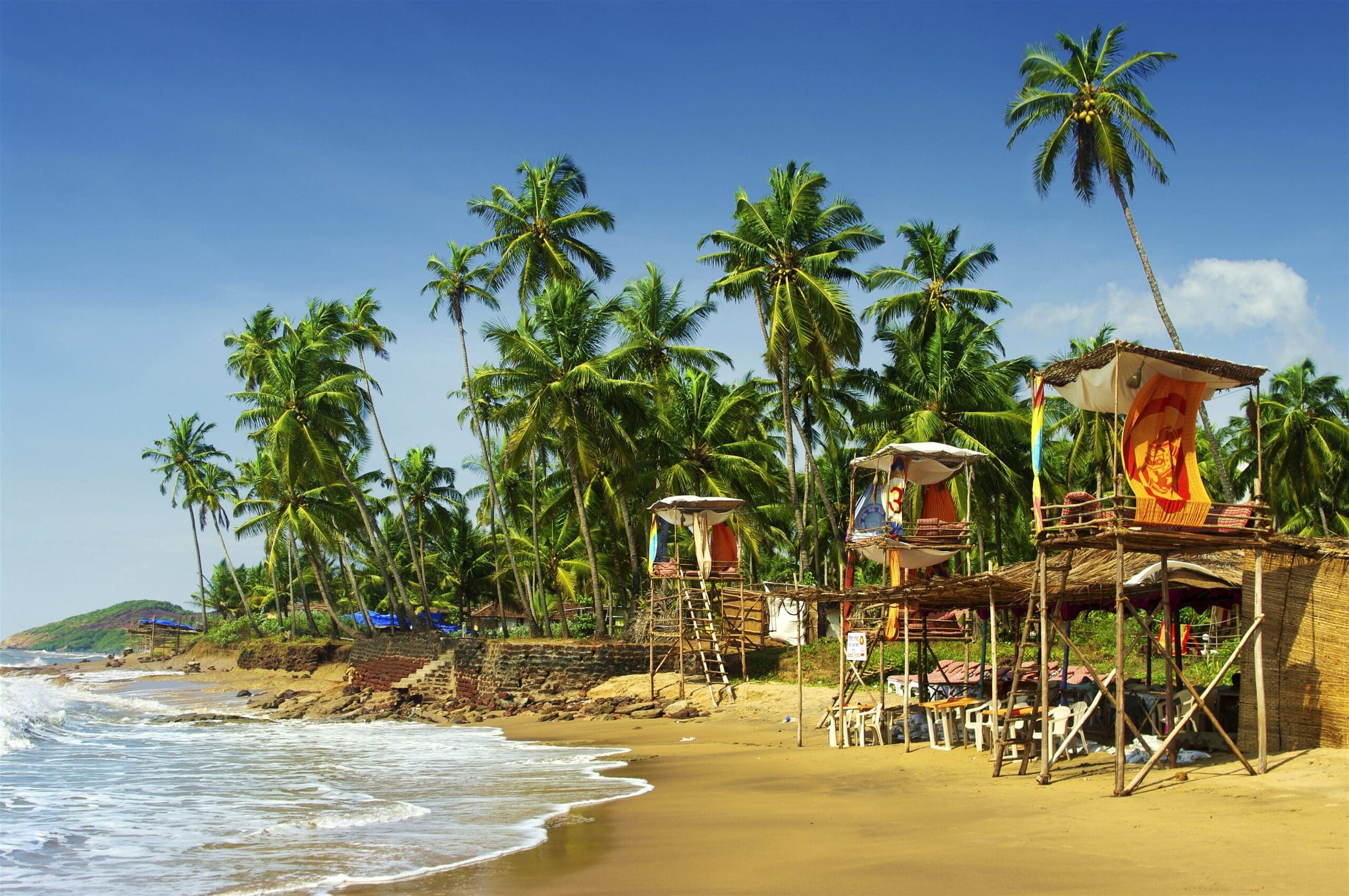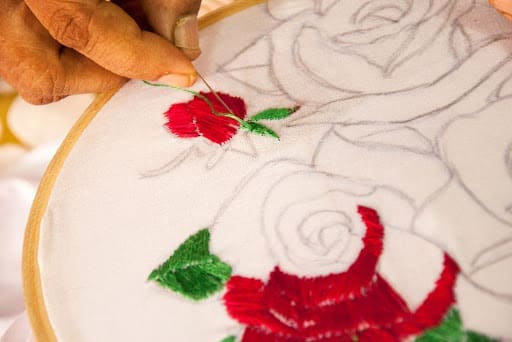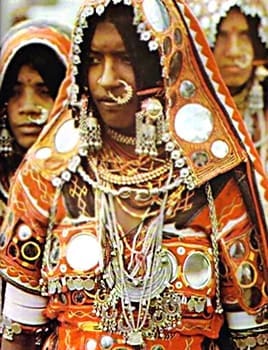Goa is a state on the southwestern coast of India within the region known as the Konkan, and geographically separated from the Deccan highlands by the Western Ghats. It is surrounded by the Indian states of Maharashtra to the north and Karnataka to the east and south, with the Arabian Sea forming its western coast. Goa is known for its beaches and heritage all over the world, this small state has given birth to craftsmen and artists from all spheres of life.
Textiles of Goa
The Kunbi
The Kunbi tribe is believed to be the oldest tribe of Goa. This tribal community is industrious and hard working, with the advent of the Portuguese rule in Goa these people originally Hindus, were converted to Christians. However their culture and rituals have a touch of Hinduism.
The Kunbi dance is a famous dance with the Kunbi women dancers dancing to the beats wearing brightly colored Kunbi saris. This saree was originally worn by Kunbi and Gawda tribe women who were basically paddy field workers. This community is basically closer to nature. This is the main reason the drape of this saree is simple, the length is just below the knee and gives freedom to the Kunbi workers to carry on with their daily chores and hard field works. Though the saree is not easily available in the market nowadays, these tribal women still adore this drape of saree and prefer wearing it the same way, but using other cotton sarees or even synthetic sarees.
Originally the Kunbi saree was dyed in red and black and woven in small and large checks. The dye was obtained from recipe of iron ore, rice kanji (starch) and vinegar. All this abundantly found in Goa. This saree was originally worn without the choli; however it was worn with a simple blouse having puffed sleeves. The traditional Kunbi women used to adorn herself with simple glass red and green bangles and with strands of black beads necklace.
Although this saree has got its traditional roots and is considered very ethnic, the weave on the saree is simple checkered look, differentiating it to be in the class of geometric designs from the textile designers point of view. The saree is almost extinct in the lights of modernization. As most of the members of the community are moving towards greener pastures, this garment has lost its glory. With the literacy rate being improved in the state of Goa, members of this community prefers to have white collared or government jobs rather than being agriculture producers.
Hand Embroidery of Goa
Calangute
Hand embroidery is one of the oldest and richest of handicraft, which consists of decorating a piece of fabric with needle and various types of yarns, by creating intrinsic and amazingly beautiful stitches over the fabric.
Usually the embroidery is done on a cotton, velvet or a satin cloth, for which the required cloth is taken, and is cut according to the required measurements, once the cutting is done, it is then marked with required designs and motifs, the way of transferring designs depends upon the region where the embroidery is done, in few places it is transferred with the help of butter paper, in few places it is drawn directly upon the cloth, in few places templates are used. Whichever the techniques are, embroidery requires a special skill set and an artistic eye for detailing, the cloth with design is fixed onto a circular ring, which is called as embroidery frame. And embroidery is done on the design, using colorful threads an artisan creates literally a poetry from the needle, artisan makes sure to fill the design motifs with embroider stitches and continues all over the printed designs to fill up the design. Usually a bed spread, table cloth, or wall hangings are made out of embroider products andalso there are hand kerchiefs, curtains and other decorative products are done.
Products made with this embroidery
• Table Cloth – It is used in decorating dining, tea tables.
• Bed Spread – It is used as a bed sheet, a plain cloth with usually indicative embroidery
• Wall Hangings – It is used as a wall hanging decorative piece
Traditional Dresses of Goa

The pristine and romantic beaches of Goa are immensely popular among the domestic as well as international tourists. The fusion of the eastern and western culture is aptly reflected in the dressing style of the Goans. The various dresses of the Goans are as follows :
Nav Vari – A 9 yard saree, which is worn along with attractive accessories.
The fishermen of koli wear brightly colored shirts, half pants and bamboo hats. This dress has become very popular as a signature Goa dress and is worn by numerous tourists.
Valkal – A string of beads and leafy loincloths, which is still prevalent in the tribal life.
Kashti – A traditional attire worn by the Dhangar, Gauda, Kunbi, Velip and Zalmi tribes along with Kunbi palloo or the tied knot and saree.
The Goa Carnival is very popular for the colorful exhibition of dresses it showcases. The vividly colored costumes and props, which are based on theme are very famous.
Costumes of Goan Catholics:
Goan Catholics have unique culture, which is a mixture of Indian and Portuguese cultures. Portuguese came to Goa in 1510, and people of Goa adopted the culture of Portuguese but also kept following their traditions, customs and Hindu caste system. The Indo-Latin culture became famous for their outstanding clothing as well.
Costumes: Goan Catholic women commonly wear dresses/gowns. These are some of the common attires for females. Men put on the bridegroom and suits of western-style. Virgin-white gown is worn by the bride. Modern Goan Catholics usually held a White wedding. Costly outfits are purchased for the wedding day. During festivals like Easter, Good Friday and Christmas, Goan Catholics wear special clothing
Tribal People of Goa
There are four major tribes in Goa – the Gowdas, the Kunbis, the Velips and the Dhangars – who live in small groups in segregated villages. It is bewildering to see their unique lifestyle, customs, traditions, ceremonies, religious beliefs and superstitions, that have been freezed over the centuries. In many respects, their lifestyles could be termed ‘primitive’ and akin to the stone age. Yet, while we may call them primitive, in so many ways they are more civilised as all their habits, customs and traditions originate from the soil. They are basic and are untouched by the economic, technological and scientific changes that have taken place in the ‘developed’ world.
The Gowdas
There is no official record of where or from which direction the Gowdas may have migrated to Goa. However, legends float in the air and you can sniff many of those. Some scholars have linked them to the Gowda community of Bengal, because of many similar customs and traditions. Believed to derive their name from the Sanskrit word “Gaon” for village, they are said to be among the earliest inhabitants of Goa. The Gowdas are Hindus, with no specific hierarchial order and don’t marry outside their community. You can find them consonant in many ways with the Velips, save the role and rights of women in their society. Women play a very active role in economic, social and political activities, but ironically are not allowed to participate in religious rituals, even in those related to the clan deity in the family house. The festivals of the Gowda tribe is an interesting thing to behold. By singing and dancing around Malikkarjun (Lord Shiva), the main deity, they indeed create a magnificent vista.
The Kunbis
Known to be very simple and hardworking people, the Kunbis are short in stature and very shy. Even today they continue to retain their simplicity and believe in adhering to their age-old customs and traditions. Plan a holiday trip to the interiors and you can witness an unique lifestyle breathing in the waves of antiquity. What a simple life they lead! Nurturing lush green fields and dwelling in small huts made of mud walls with bamboo roofs adorned with coconut palm leaves or straws. The Kunbis are an excellent example of a living community, blessed with strong links with relatives and others. They live together, clustered into several hamlets, known as ‘kutumba’, from the Sanskrit word ‘kutumbakam’ which means a family. Kunbis have a rich tradition of art and culture to which they attach particular importance. Listen to their songs, that are melodious, behold their dances, that are colourful. Participate during the spring festival of Shigmotsav in February-March, and you can have the pleasure to behold one of the grand ceremonies of tribal Goa. Applauded as a highly choreographed affair, this festival floats with different folk themes that make their way through the main streets.
Velips
Said to be one of the sub-castes of the Kunbis, interestingly they trace their pedigree to the stone age. Nestling at the stone-age site discovered recently at Kajur, they also practise a concept akin to that of the pre-historic period. Nevertheless, the Velips while having some commonality with the Kunbis, have their own very marked and distinguishing features, not only in regard to customs and rituals, but also racially. One of the features that you may find interesting, is their notion behind surnames. The name Velips refers to those whose ancestors settled in a Goan village are called ‘Gaonkar’ (Sanskrit, Gaon : village). The surname ‘Zarkar’ is derived from the word ‘Zara’ which means a fountain. ‘Dahikar’ is another surname derived from the word ‘Dahi’ (yoghurt). Unlike other tribes, joint family system is prevalant among the Velips and also, they are economically more stable.
Dhangers
The Dhangars in Goa are recognised as shepherds caressing a semi-nomadic lifestyle. Legend has it that they were created from the dust of Lord Shiva’s body. You will find it easy to identify them because of their dressing and occupation which separates them from other communities in the region. When theytake their cattle grazing, they invariably carry a stick and are accompanied by one or two hunter dogs. Polygamy is a common practise, and the bride is normally purchased in exchange of cash and kind.
Art and Crafts of Goa
A land of blended cultures, the unison finds expression in the art and crafts of Goa. While on a trip to Goa, its difficult to resist temptation to buy souvenirs. One can see temples and churches adorned with ‘folk’ paintings. These paintings usually depict scenes from Mahabharata or Ramayana or the new testaments. The museums and art galleries in Goa also carry numerous examples of the Goan art. And not just the churches and the art galleries, you can catch glimpses of how the Portuguese and Indian forms merge in humble house holds.
Among the crafts of Goa, there is no end. Its difficult to pick what is best, the exquisitely carved rosewood and teak furniture, the terracotta work or the ‘visible everywhere’ sea shells work. Even in today’s Techno driven world, these hand made souvenirs look so inviting on the counters of shops.
The art and craft of Goa, like its culture has come out of a blend of Indo-Portuguese art forms. Capturing the fancy of Goans as well as tourists, Goa craft has won critical acclaim from the connoisseurs of the art world. Some prominent crafts forms in Goa are the bamboo craft, woodcarving, brass metals, sea shell crafts, paper mache and wooden lacquer ware.
Pottery And Terracotta
While pottery is art of traditional form made with earthen clay, terracotta is ceramic clay. These are the traditional crafts forms of Goa. Utility cum decorative items are made out of these such as flower garden pots, pen holders, ashtrays, bowls, statues of saints and goddesses. They also draw inspiration from religious or historical themes. Borde and Bicholim are two famous centres of earthenware, though pottery is made all over Goa.
Brass Metal Work
Brass items are very famous with tourists especially samais. This craft is available in plenty in the markets of Goa. Unlike utility items which are made from sheet metal, brass metal is a different thing. The craft is passed from one generation to another and practiced on heredity basis. Its used mainly for casting decorative items like oil lamps, church bells, candle stands, ashtrays and temple towers etc.
Laquerware / Wood turning
Wood turning is a form of woodcarving that is used to create wooden objects (e.g. a bowl or a table leg) on a lathe using cutting tools. Wood turning differs from most other forms of woodworking, here the wood is moving while a (relatively) stationary tool is used to cut and shape it. You will get cradles, baby carts, toys, corner stands, etc in Goa made by wood turning.
Crochet And Embroidery
The importance of crochet in Goa can be realized by the fact that every bride brings her crochet and embroidery work as dowry which is then displayed to demonstrate her expertise in the craft. Crochet and embroidery in Goa is inherent to every household where it is passed from one generation to another. Though the craft of crochet and embroidery has been in India since time immemorial but it came to Goa with the arrival of nuns and missionaries in fifteenth century. And thus started this tradition of crochet and embroidery in Goa which has only improved in quality and design since. The items made are hankies, table clothes, children and ladies garments, pillow and cushion covers and bed spreads etc.
Bamboo Craft
Bamboo craft initially was more of a utility based thing where in ‘mahras’, a scheduled community made items required by farmers and fishermen. They made things to store food grains, sell fish. Many utility items made out of bamboo are still used in villages like baskets, valli and supli (for washing and cleaning rice) and dali used as floor cover or to dry food grains. With time this traditional craft has taken shape of decorative cum utility items. Different types of flower baskets, flower pots, letter stands, fans etc are some common items now sold.
Fiber Craft
Nuns from Kerela brought the fiber craft to Goa. Fiber articles were earlier produced for utility purposes. This craft comes in handy keeping in mind the changing living style. The function of fiber is combined with some ornamentation to bring out some attractive and colorful items. Shopping bags, ladies purses, coasters, wall hangings are made by some women organizations of Goa using banana or sisal fiber.
Referance
https://en.wikipedia.org/wiki/Goa
https://www.fibre2fashion.com/industry-article/6838/traditional-saree-of-goa
https://www.dsource.in/resource/hand-embroidery-calangute-goa/products
https://www.hinduscriptures.in/vedic-society/dresses/costumes-of-goa
https://goyanchisanskriti.blogspot.com/2017/02/traditional-dresses-of-goa.html
https://traditionalclothingindia.blogspot.com/2014/01/traditional-clothing-for-men-and-women.html
https://www.indialine.com/travel/goa/art-craft.html

Ms. Sidrah Mubin Patel. B.Sc. in Textiles and Apparel Designing, Sir Vithaldas Thackersey College of Home Science.
Textile Value Chain Intern. Email: tvcmedia.digital@gmail.com











